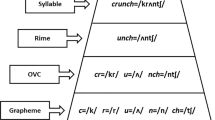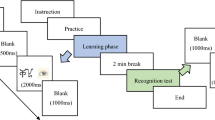Abstract
Nine-ten-and twelve-year-old children (N = 75) read aloud dominant, subordinate or ambiguous bias sentences (N = 120) that ended in a homonym (BALL). After the sentence (1,000 ms), children read aloud targets that were related to the dominant (BAT) or subordinate (DANCE) meaning of the homonym or control targets. Participants were also divided into three reading skill groups based on an independent measure of single word oral reading accuracy. There were three main developmental and reading skill findings. First, 9-year-olds and low skill readers showed lexical level facilitation in accuracy. Second, 9- and 10-year-olds or low and moderate skill readers showed lexical level facilitation in reaction time. Third, 12-year-olds or high skill readers showed sentence level facilitation in reaction time with high skill readers additionally showing sentence level inhibition in reaction time. These results show that lexical level context effects decreased and that sentence level context effects increased with development and skill. These results are discussed in terms of connectionist models of visual word recognition that incorporate distributed attractor principles.
Similar content being viewed by others
References
Adams M.J., Huggins A.W.F. (1985). The growth of children’s sight word vocabulary: A quick test with educational and theoretical implications. Reading Research Quarterly. 20, 560–568
Backscheider A.G., Gelman S.A. (1995). Children’s understanding of homonyms. Journal of Child Language. 22,(1): 107–127
Booth J.R., Hall W.S. (1994). Role of the cognitive internal state lexicon in reading comprehension. Journal of Educational Psychology. 86, 413–422
Booth J.R., Hall W.S. (1995). Development of the understanding of the polysemous meanings of the mental-state verb know. Cognitive Development. 10, 529–549
Booth J.R., Hall W.S., Robinson G.C., Kim S.Y. (1997). Acquisition of mental state verbs by 2- to 5-year old children. Journal of Psycholinguistic Research. 26, 581–603
Briggs, P., Austin, S., & Underwood, G. (1984). Effects of sentence context in good and poor readers: A test of Stanovich’s interactive compensatory model. Reading Research Quarterly (Fall), 54–60
Carpenter P.A., Daneman M. (1981). Lexical retrieval and error recovery in reading: A model based on eye fixations. Journal of Verbal Learning and Verbal Behavior. 20(2): 137–160
Cohen J.D., MacWhinney B., Flatt M., Provost, J. (1993). PsyScope: An interactive graphic system for designing and controlling experiments in the psychology laboratory using Macintosh computers. Behavior Research Methods, Instruments, and Computers. 25, 257–271
Cramer P. (1983). Homonym understanding and conservation. Journal of Experimental Child Psychology. 36(2): 179–195
Crystal D. (1992). An encyclopedic dictionary of language and languages. Cambridge, MA: Blackwell
Dixon P., Twilley L.C. (1999). Context and homograph meaning resolution. Canadian Journal of Experimental Psychology. 53(4): 335–346
Duffy S.A., Morris R.K., Rayner K. (1988). Lexical ambiguity and fixation times in reading. Journal of Memory and Language. 27, 429–446
Durkin K., Shire B. (1991). Primary school children’s interpretations of lexical ambiguity in mathematical descriptions. Journal of Research in Reading. 14(1): 46–55
The Educator’s Word Frequency Guide (1996). Brewster, NY: Touchstone Applied Science Associates, Inc.
Gernsbacher M.A., Faust M.E. (1991). The mechanism of supression: A component of general comprehension skill. Journal of Experimental Psychology: Learning Memory and Cognition. 17: 245–262
Gernsbacher M.A., Robertson R.R.W. (1995). Reading skill and suppression revisited. Psychological Science. 6, 165–169
Gernsbacher M.A., Varner K.R., Faust M.E. (1990). Investigating differences in general comprehension skill. Journal of Experimental Psychology: Learning, Memory, & Cognition. 16(3): 430–445
Glucksberg S., Kreuz R.J., Rho S.H. (1986). Context can constrain lexical access: Implications for models of language comprehension. Journal of Experimental Psychology: Learning, Memory, & Cognition. 12(3): 323–335
Hogaboam T.W., Perfetti C.A. (1975). Lexical ambiguity and sentence comprehension. Journal of Verbal Learning and Verbal Behavior. 14, 265–274
Kail R. (1993). Processing time decreases globally at an exponential rate during childhood and adolescence. Journal of Experimental Child Psychology. 56(2): 254–265
Kail R., Hall L.K. (1994). Processing speed, naming speed, and reading. Developmental Psychology. 30(6): 949–954
Kawamoto A.H. (1993). Nonlinear dynamics in the resolution of lexical ambiguity: A parallel distributed processing account. Journal of Memory and Language. 32, 474–516
Kintsch W., Mross F. (1985). Context effects in word identification. Journal of Memory and Language. 24, 336–349
Marmurek H.H.C., Rossi M. (1993). The development of strategic processing of ambiguous words: Riddles versus neutral context. Journal of Genetic Psychology. 154(4): 475–486
Martin C., Vu H., Kellas G., Metcalf K. (1999). Strength of discourse context as a determinant of the subordinate bias effect. Quarterly Journal of Experimental Psychology. A, Human Experimental Psychology, 52A(4): 813–839
Neill W.T., Hilliard D.V., Cooper E.A. (1988). The detection of lexical ambiguity: Evidence for context sensitive parallel access. Journal of Memory and Language. 27, 279–287
Nelson, D. L., McEvoy, C. L., & Schreiber, T. A. (1998). The University of South Florida word association, rhyme, and word fragment norms.: http://www.usf.edu/FreeAssociation/
Perfetti C.A., Roth S. (1981). Some of the interactive processes in reading and their role in reading skill. In: Lesgold A. Perfetti C.(eds) Interactive processes in reading. Hillsdale, NJ: Erlbaum
Perfetti C.A., Goldman S.R., Hogaboam T.W. (1979). Reading skill and the identification fo words in discourse context. Memory and Cognition. 7, 273–282
Plaut D.C., Booth J.R. (2000). Individual and developmental differences in semantic priming: Empirical findings and computational support for a single-mechanism account of lexical processing. Psychological Review. 107(4): 786–823
Raduege T.A., Schwantes F.M. (1987). Effects of rapid word recognition training on sentence context effects in children. Journal of Reading Behavior. 19, 395–414
Schwantes F.M. (1981a). Effect of story context on children’s ongoing word recognition. Journal of Reading Behavior. 13, 305–311
Schwantes F.M. (1981b). Locus of the context effect in children’s word recognition. Child Development. 52, 895–903
Schwantes F.M. (1982). Text readability level and developmental differences in context effects. Journal of Reading Behavior. 14, 5–12
Schwantes F.M. (1985). Expectancy, integration, and interactional processes: Age differences in the nature of words affected by sentence context. Journal of Experimental Child Psychology. 39, 212–229
Schwantes F.M., Boesl S.L., Ritz E.G. (1980). Children’s use of context in word recognition: A psycholinguistic guessing game. Child Development. 51, 730–736
Simpson G.B. (1981). Meaning dominance and semantic context in the processing of lexical ambiguity. Journal of Verbal Learning & Verbal Behavior. 20(1): 120–136
Simpson G.B., Burgess C. (1985). Activation and selection processes in the recognition of ambiguous words. Journal of Experimental Psychology: Human Perception & Performance, 11(1): 28–39
Simpson G.B., Forster K.I. (1986). Lexical ambiguity and children’s word recognition. Developmental Psychology. 22, 147–154
Simpson G.B., Krueger M.A. (1991). Selective access of homograph meanings in sentence context. Journal of Memory and Language. 30, 627–643
Simpson G.B., Krueger M.A., Kang H., Elofson A.C. (1994). Sentence context and meaning frequency effects in children’s processing of ambiguous words. Journal of Research in Reading. 17(1): 62–72
Spieler, D. A. & Balota, D. H. (2001). Word Naming Corpus: 2870 Single Syllable Words and Associated Naming Latencies (http://elexicon.wustl.edu/).
Stanovich K.E., Nathan R.G., West R.F., Vala-Rossi M. (1985). Children’s word recognition in context: Spreading activation, expectancy, and modularity. Child Development. 56, 1418–1428
Stanovich K.E., West R.F., Freeman D.J. (1981). A longitudinal study of sentence context effects in second grade children: Tests of the interactive-compensatory model. Journal of Experimental Child Psychology. 32, 185–199
Swinney D.A. (1979). Lexical access during sentence comprehension: Reconsideration of context effects. Journal of Verbal Learning and Verbal Behavior. 18, 645–659
Tanenhaus M.K., Lieman J.M., Seidenberg M.S. (1979). Evidence for multiple stages in the processing of ambiguous words in syntactic contexts. Journal of Verbal Learning and Verbal Behavior. 18, 427–440
Twilley L.C., Dixon P. (2000). Meaning resolution processes for words: A parallel independent model. Psychonomic Bulletin & Review. 7(1): 49–82
Twilley L.C., Dixon P., Taylor D., Clark K. (1994). University of Alberta norms of relative meaning frequency for 566 homographs. Memory and Cognition. 22, 111–126
Van Petten C., Kutas M. (1987). Ambiguous words in context: An event-related potential analysis of the time course of meaning activation. Journal of Memory and Language. 26, 188–208
Vu H., Kellas G., Metcalf K., Herman R. (2000). The influence of global discourse on lexical ambiguity resolution. Memory & Cognition. 28(2): 236–252
Vu H., Kellas G., Paul S.T. (1998). Sources of sentence constraint on lexical ambiguity resolution. Memory & Cognition. 26(5): 979–1001
West R.F., Stanovich K.E. (1978). Automatic contextual facilitation in readers of three ages. Child Development. 49, 717–727
West R.F., Stanovich K.E. (1988). How much of sentence priming is word priming?. Bulletin of the Psychonomic Society. 26, 1–4
West R.F., Stanovich K.E., Freeman D.J., Cunningham A.E. (1983). The effect of sentence context on word-recognition in second-and sixth-grade children. Reading Research Quarterly. 19, 6–15
Woodcock R.W. (1987). Woodcock Reading Mastery Tests - Revised. Circle Pines, MN: American Guidance Service
Author information
Authors and Affiliations
Corresponding author
Rights and permissions
About this article
Cite this article
Booth, J.R., Harasaki, Y. & Burman, D.D. Development of Lexical and Sentence Level Context Effects for Dominant and Subordinate Word Meanings of Homonyms. J Psycholinguist Res 35, 531–554 (2006). https://doi.org/10.1007/s10936-006-9028-5
Published:
Issue Date:
DOI: https://doi.org/10.1007/s10936-006-9028-5




